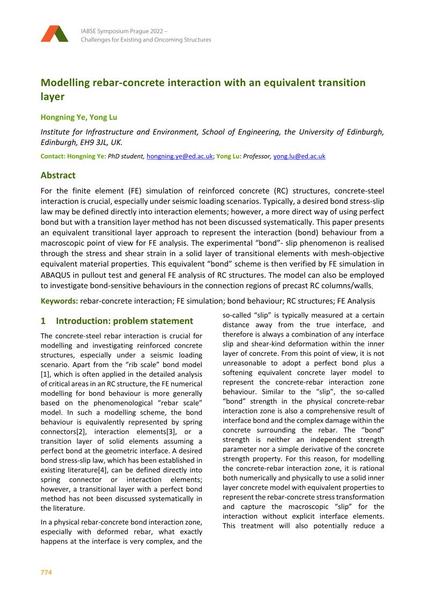Modelling rebar-concrete interaction with an equivalent transition layer

|
|
|||||||||||
Bibliografische Angaben
| Autor(en): |
Hongning Ye
(Institute for Infrastructure and Environment, School of Engineering, the University of Edinburgh, Edinburgh, EH9 3JL, UK.)
Yong Lu (Institute for Infrastructure and Environment, School of Engineering, the University of Edinburgh, Edinburgh, EH9 3JL, UK.) |
||||
|---|---|---|---|---|---|
| Medium: | Tagungsbeitrag | ||||
| Sprache(n): | Englisch | ||||
| Tagung: | IABSE Symposium: Challenges for Existing and Oncoming Structures, Prague, Czech Republic, 25-27 May 2022 | ||||
| Veröffentlicht in: | IABSE Symposium Prague 2022 | ||||
|
|||||
| Seite(n): | 774-782 | ||||
| Anzahl der Seiten (im PDF): | 9 | ||||
| DOI: | 10.2749/prague.2022.0774 | ||||
| Abstrakt: |
For the finite element (FE) simulation of reinforced concrete (RC) structures, concrete-steel interaction is crucial, especially under seismic loading scenarios. Typically, a desired bond stress-slip law may be defined directly into interaction elements; however, a more direct way of using perfect bond but with a transition layer method has not been discussed systematically. This paper presents an equivalent transitional layer approach to represent the interaction (bond) behaviour from a macroscopic point of view for FE analysis. The experimental “bond”- slip phenomenon is realised through the stress and shear strain in a solid layer of transitional elements with mesh-objective equivalent material properties. This equivalent “bond” scheme is then verified by FE simulation in ABAQUS in pullout test and general FE analysis of RC structures. The model can also be employed to investigate bond-sensitive behaviours in the connection regions of precast RC columns/walls. |
||||
| Stichwörter: |
FE-Analyse Verbundverhalten
|
||||
| Copyright: | © 2022 International Association for Bridge and Structural Engineering (IABSE) | ||||
| Lizenz: | Die Urheberrechte (Copyright) für dieses Werk sind rechtlich geschützt. Es darf nicht ohne die Zustimmung des Autors/der Autorin oder Rechteinhabers/-in weiter benutzt werden. |
||||
